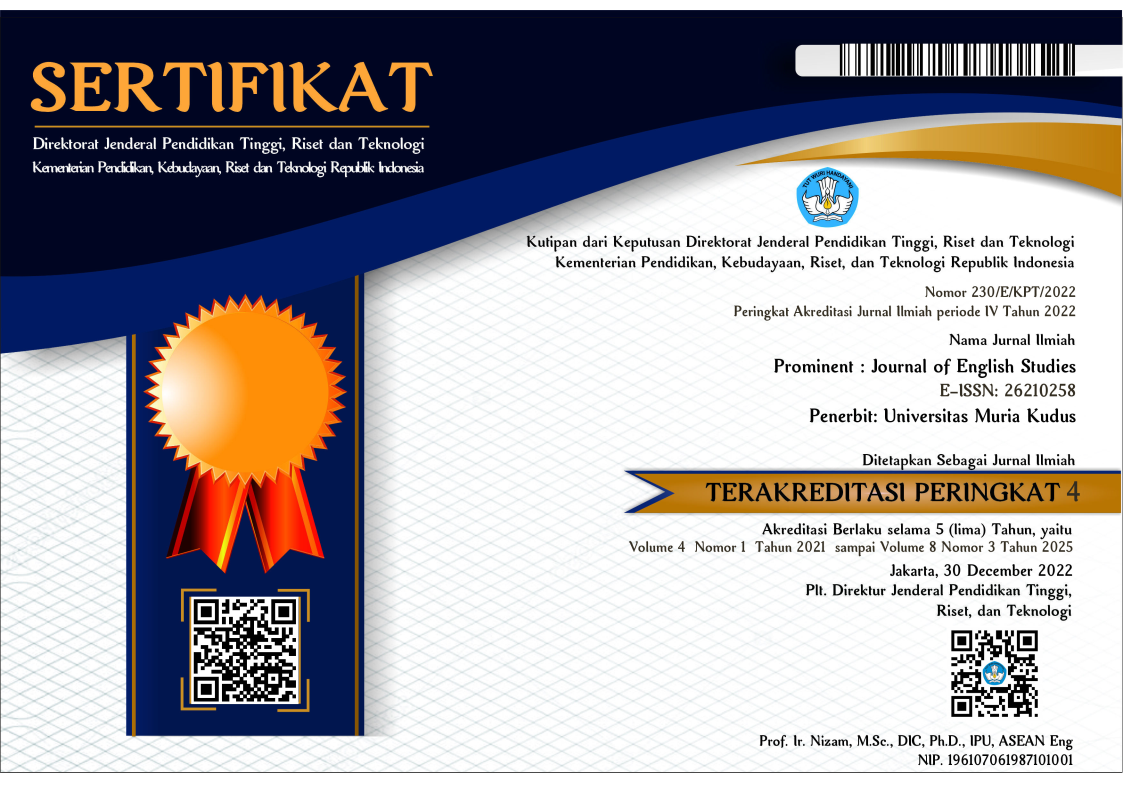STUDENTS’ PERCEPTIONS TOWARD ANIMATED VIDEOS-BASED TEACHING MATERIALS (A STUDY CASE IN SEVENTH GRADE)
Abstract
Abstract:
Technology has very important rules in our learning activities nowadays. It can be used for learning media in the EFL classroom. One of the blended learning media in the Merdeka Curriculum that can be used today is animated video. This study’s purpose is to investigate students’ perception of animated video-based teaching materials in seventh-grade students. This study of qualitative research with a survey design using an online questionnaire as an instrument. The result of this study shows students’ perception of animated video-based teaching materials in the seventh grade has fulfilled the Technology Acceptable Model (TAM). The results showed that 33 students agreed to animated video as a medium of learning. It showed the highest percentage of pronouncement of agreement. The data analyst found that students’ perception through animated videos has five components of TAM which showed the pronouncement of agreement. In addition, an animated video was effectively used as media for learning. In this case, the researcher found the research in the Junior High School of SMP Negeri 6 Semarang. In this study, it can be implied that animated video is available to use in learning English-based teaching materials.
Keywords
References
Andhovita, L. G., & Wahyuni, A. (2020). Students' Perceptions Towards the use of Multimedia-Based Teaching Materials. JHSS (Journal of Humanities and Social Studies), 4(1), p.10-13. DOI: 10.33751/jhss.v4i1.1902 Gracella, J., & Nur, D. R. (2020). Students' Perception of English Learning through YouTube Application. Borneo Educational Journal (Borju), p.21-35. DOI: https://doi.otg/10.24903/bej.v2i1.623 Harlinda, N. (2019). Students' Perception of Using YouTube as Media for Learning as a Foreign Language. Palangkaraya: State Islamic Institute of Palangkaraya. Helingo, A. (2022). YouTube as Learning Medium for Promoting EFL Students' Reading Habit and Motivation. Journal English Languange of Educations, 7(1), p.28-34. https://doi.org./10.31004/jele.v7il.184 Hia, M. (2021). The Effect of Using YouTube on Students' Motivation in Learning English Vocabulary. Dialectical Litelature and Education Journal, 6(2), p.62-71. Ju, S. Y & Mei, S. Y. (2020). Students' Attitude and Perception of Learning Mandarin Chinese via Animated Video. International Journal of Academic Research in Bussiness and Social Sciences, 10(10), p.567-579. Mazariri, E. T., Gapa, P., & Tinashe, C. (2020). Student Perceptions Educations Towards the use of YouTube as An Educational Tools for Learning and Tutorials. International Journal of Instruction, 13(2), p.119-138. DOI: 10.29333/iji.2020.1329a Munawir, A., Inayah, N., Putriani, F. N., & Huda, N. (2022). Students' Vocabulary Mastery By Using Animation Video on English Language Teaching. Indonesian Journal of Research and Educational Review (IJER), 1(3), p.354-362. DOI: https://doi.org/10.51574/ijrer.v1i3.391 Munawir, A., Puriani, F. N., Huda, N., & Inayah, N. (2022). Students' Vocabulary Mastery by Using Animation Videos on English Language Teaching. Indonesian Journal of Research and Educational Review, 1(3), p.354-362 Nurdyansyah, N., Mandarani, V., & Rais, P. (2020). How to Make Use of Animation to improve Primary School Students' English Achievement? Journal of English Educators Society, 5(1), p.53-59. Putri, H. R. (2022). The Effectiveness of Teaching Speaking by Using Drilling Method through YouTube. Journal of English Teaching, Litelature, and Applied Linguistics, 6(2), p.70-81. Shopia, K., Sabila, D., & Purnawati. (2022). Students' Interest in Learning English Through YouTube (A Case Study in Senior High School of Sekolah Alam Cikeas Bogor) . STAIRS: English Language Education Journal, 3(1), p.10-18. Tahmina, T. (2023). Students' Perception of the Useof YouTube in English Language Learning. JOLLT Journal of Language and Language Teaching, 11(1), p.151-159.
DOI: https://doi.org/10.24176/pro.v6i2.10201
Refbacks
- There are currently no refbacks.
Prominent Journal of English Studies is licensed under a Creative Commons Attribution-ShareAlike 4.0 International License.
Dedicated to:

in Collaboration with APSPBI:





